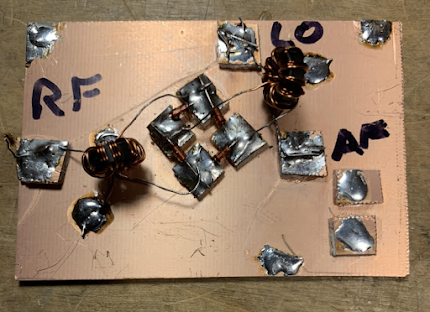A team from the Vienna Wireless Society was back in the local high school Thursday and Friday of this week, helping the students finish their variable frequency oscillators and build their diode ring mixers. Club President Dean KK4DAS was in the lead, and did an amazing job working with the school and procuring all the needed parts. Mike KD4MM and Don KM4UDX provided patient and understanding help to the students.
On the oscillators, the students had to add about six parts to install a buffer circuit built around a J310 FET. They also had to replace some of the 3D printed coil forms for the main-tuning variable inductor. (Dean KK4DAS made some really nice forms -- see below.) Several teams of students experiences were very pleased to get their oscillators running.
Then it was on to the diode ring mixer. We had planned on having the students wind their own trifilar toroids, but we realized that this might be too much -- it would add a lot of time to the build, and would introduce a lot opportunity for error.
I remembered that Farhan had given me a big supply of FT-37-43 trifilar toroids that had been assembled in Hyderabad. We decided to use these transformers. We reasoned that this was not a big deviation from our DIY ethos -- after all, we didn't ask the student to wind their audio transformers, nor did they wind the RF choke in the VFO buffer. But we faced a problem: the Hyderabad transformers were all wound with the same color wire on all three turns. This would make it hard for the students to figure out which wire went where (there were 12 such wires on each mixer board!). I figured out how to do this: The night before, I soldered together the center tap wires, and I twisted together the input coil wires. We told the students to first solder the center taps in place, then solder the two free wires to the diode ring, and finally untwist the input coil wires, soldering in these connections. This worked.
Before we started, I gave the students a quick class on the essentials of mixers. And I pointed out that we were using transformers made in Hyderabad India and donated by our friend Farhan. I told the students that whenever we include parts given to us by a ham radio friend we are adding "soul to the new machine." Indeed, Farhan's toroids added a lot of soul.
We have been insisting that the students have each stage tested before moving on to the next. This week we used signal generators to put RF and VFO energy into the mixers, and oscilloscopes to make sure that audio was coming out.
The students are making good progress. After today's session we did an estimate of where each of the projects stand at this point:
Oscillation without the buffer: 11
Oscillation with the buffer: 5
Mixer built and tested (but no diplexer yet): 5
Mixer working, diplexer built 2








No comments:
Post a Comment